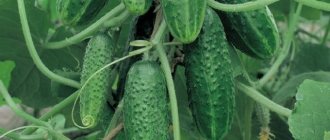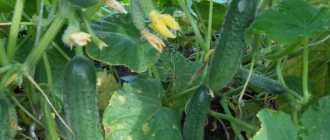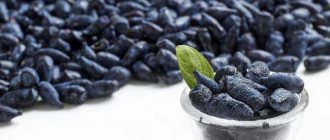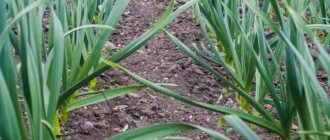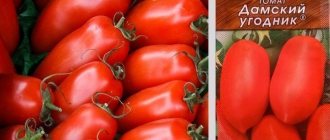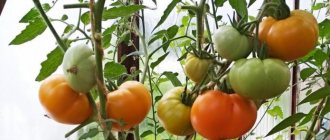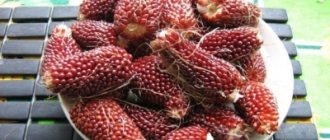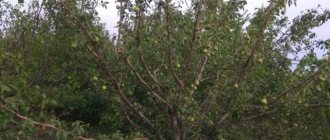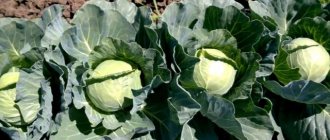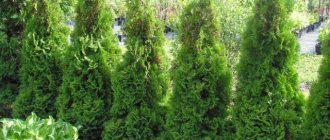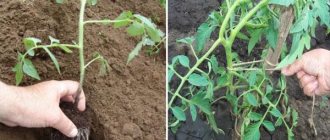Description of the Prestige variety
The hybrid is mid-early, the maturation of greens is observed in 45-50 days. It was developed by specialists from the Sedek company in 2007. The bush grows compactly and takes up minimal space when grown on a trellis. Climbing is at an average level, leaves are formed in an average number. Female type flowering.
The flesh is juicy, crispy, but not hard, the skin is easy to chew
Zelentsy are cylindrical in shape. They grow about the same size, 8-10 cm in length and about 50-95 g. The skin has small tubercles and an abundance of thorns, which have to be removed before use. The color is dark green with light stripes. The taste is pleasant. The flesh is juicy, crispy, but not hard, the skin is easy to chew.
Interesting!
Prestige cucumbers are formed along the entire length of the vine, so when harvesting you need to carefully inspect the entire bush.
Seedling technology
Prestige cucumbers were developed for open ground in the climatic zone of central Russia. But they will feel equally good under film cover and on the balcony. Just don’t forget that this is an indeterminate plant and, like a liana, is practically unlimited in growth. Depending on the planting conditions, a decision is made as to whether it is necessary to pinch.
Prestige cucumbers planted in a greenhouse using seedlings must be limited in growth, but they can produce a good harvest from the beginning of May. To do this, the seedlings are transferred to specially prepared beds, starting in April and during the first month, heating the greenhouse is required. When grown on a loggia, Prestige can bear fruit long after the first frost. Naturally, they need additional care.
Depending on how the cucumbers are planted, the time for harvesting the first harvest depends. If you want to get an early harvest, you should use the seedling planting method. For the May harvest, seeds are planted in March. It is better to use individual peat pots.
To obtain the first harvest in June, seeds are planted for seedlings in April. They are planted in the ground in mid-May. In this case, there is no need to create greenhouse conditions. The main thing is to protect the plants from late frosts.
The use of seedling growing methods can speed up the fruiting time of cucumbers by a couple of weeks. “Prestige-f1” cucumbers should be sown as seedlings approximately a month before planting on the site:
- you need to bury the seeds in light and fertile soil, which fills pots or cups with a height of 8-9 cm by about 1.5-2 cm;
- the minimum temperature at night should be maintained at 14-15°C, and during the day the temperature should not be lower than 18-20°C;
- in the morning you need to water no more than twice a week with settled, warm water;
- after the appearance of the second leaf on the seedlings, the plants should be fed with nitroammophos or the “Breadwinner” product;
- Hardening of seedlings must begin 10 days before planting plants in open ground or on greenhouse beds.
We also invite you to learn about the varietal characteristics of Pasadena f1 cucumbers.
Advantages of Prestige F1 cucumbers
Also check out these articles
- Description and characteristics of the Cinderella incubator
- The best varieties of columnar cherries
- Why do chickens lay small eggs?
- Food for large turkeys
Before purchasing and planting a Prestige F1 cucumber, you need to find out what advantages the hybrid has in general.
- Prestige F1 is a parthenocarpic species. It does not require pollination by bees and does not form barren flowers.
- The taste is rated at the highest level. It is sweet, without bitterness, with a pleasant aftertaste.
- The hybrid is suitable for growing in open ground, greenhouses, on the balcony and even indoors.
- The plant is resistant to stressful growing conditions, temperature changes, frequent rains or drought.
- Transportability is excellent.
- Zelentsy of commercial quality.
- The fruits are resistant to yellowing.
- Fruiting is extended, the yield is sufficient. You can collect 15-25 kg of greens per square meter.
Prestige F1 is a parthenocarpic species, does not require pollination, does not form barren flowers
Important!
The Prestige F1 cucumber hybrid can be grown using a simple method, horizontally, so that the vines spread along the ground or on a trellis.
Advantages and disadvantages
Advantages of the Prestige hybrid:
- early fruit ripening;
- parthenocarpic type of pollination;
- excellent taste of cucumbers, dense pulp;
- versatility in cooking;
- resistance to adverse weather conditions;
- long fruiting.
Disadvantages of gardening:
- seeds from the grown harvest are not suitable for planting next time: the second generation does not inherit the quality of the first. To obtain a pure hybrid, you need to buy planting material;
- To prevent diseases and pest attacks, preventive measures are taken.
The key to a rich harvest is timely watering, fertilizing, loosening the soil, and protecting against diseases and pests.
Features of planting cucumbers
We recommend reading our other articles
- Arabian horse breed
- Grafting by copulation
- Advantages and popular models of Xingtai tractors
- Pickled plums
Prestige F1 cucumbers can be grown by direct sowing in the ground or by seedlings. But in the middle and northern regions of Russia, the seedling method is usually used to get an earlier harvest. Seeds for seedlings are sown a month before transplanting to a permanent place, to a depth of no more than 2 cm, otherwise they simply will not sprout. For the first time, they are covered with film so that they germinate faster and are opened only to water or ventilate for 10-15 minutes.
Grown cucumbers are planted in a permanent place around May.
When the seedlings appear, the seedlings need to be properly cared for, watered on time, fed as needed, provided with normal lighting and a low temperature (so that the seedlings do not stretch out). Grown cucumbers are planted in a permanent place around May.
It is necessary to plant seedlings or sow seeds in well-warmed soil (+15…+20 degrees). It must be neutral acidity, loosened, fertilized. Cucumber Prestige F1 is suitable for compact planting in a small area. The best crop predecessors are cabbage and legumes.
Interesting!
Prestige F1 is one of the few types of cucumbers that tolerate picking and transplanting well at a young age. But in order for the root system of seedlings to take root faster and not be injured, it is necessary to plant in heated soil!
If the region is warm enough and cucumbers have a lot of time to develop, you can sow the seeds immediately in a permanent place, in open or closed ground, without making seedlings. Sowing is carried out at the end of May in soil fertilized with organic matter. The planting pattern is 50x30 cm. Until the shoots appear, the bed is covered with agrofibre (white) or transparent film.
Agricultural technology and proper cultivation
The plants tolerate a lack of sun, temperature fluctuations and flaws in agricultural technology well, so when growing they practically do not cause any trouble to the gardener. Thanks to parthenogenesis, "Prestige" demonstrates excellent growth performance when cultivated in a greenhouse with limited access to pollinating insects.
IMPORTANT: When ordering seeds, you must pay attention to the fact that they are packaged in packs of “Sedek” - the only patent holder of this hybrid. Otherwise, there is a high probability of encountering misgrading.
Despite good germination, the seeds require additional pre-sowing preparation. It includes the following manipulations:
- Disinfection in a solution of potassium permanganate or hydrogen peroxide;
- Soaking in a growth stimulator (“Epin”, “Kornevin”, “Zircon”);
- Saturation with microelements using wood ash infusion;
- Bubbling in purified water.
In most regions, cultivation is carried out using the traditional seedling method. In the south (Crimea, Astrakhan region), seedless sowing in open ground is allowed. Planting in a permanent place is carried out according to the 50x70 pattern. For 1 sq.m. beds accommodate no more than 4 plants.
Caring for Prestige F1 cucumbers
Caring for Prestige F1 cucumbers does not require much effort. But it is worth considering that the better these cucumbers are cared for, the higher the yield will be.
On average, in hot weather Prestige is watered 1-2 times a day, and in the rainy season - 1 time every 3-4 days
- Water the bushes as needed. Depending on the climate and weather, the amount and abundance of water applied may vary. On average, in hot weather they are watered 1-2 times a day, and in the rainy season - 1 time every 3-4 days.
- After watering, the soil may become crusty. If this happens, you need to loosen it.
- Fertilizers are applied 5-6 times a year. Although this depends on the quality of the soil. The less nutrients there are in the soil, the more often fertilizers are applied. But in any case, you shouldn’t do this more than once a week. And organic matter can be applied to the bushes no more than 3 times a year.
- To prevent the bushes from getting sick, regular treatment is required. Chemistry is most often used - it is more effective, but you need to understand that this option is fraught with a considerable threat - the accumulation of toxins and nitrates in the fruits. So it’s better to choose biological fungicides or folk remedies.
With proper planting and care, the Prestige cucumber will delight you with high yields and excellent quality fruits.
Rules of care
https://www.youtube.com/watch?v=X6Cddm98Mi0
Technologies for growing cucumbers in greenhouses and on ridges in open ground are somewhat different. A new generation hybrid with intensive fruiting and super-yielding “Prestige-f1” is easy to grow if you follow some basic cultivation rules:
- During the summer period, 4-5 feedings are carried out, and it is necessary to alternate mineral and organic fertilizers;
- Watering growing cucumbers before the flowering phase should be done moderately, spending approximately 4 liters per square meter every five days;
- during flowering and fruiting, watering is carried out at the rate of 10 liters per square meter every three days;
- It is recommended to form plants into one main stem and leave all side shoots.
Harvesting and processing
When canned, Prestige cucumbers keep their shape well, the flesh remains crispy
The first cucumbers can be picked at the end of June. Fruiting is extended, so the last green plants are harvested before the end of September. The harvest is harvested on average once a week. It can be more or less often. They ripen quickly, but do not outgrow and do not form barrels, so if you cannot come to collect the harvest, you don’t have to rush too much.
The use of the variety is universal. Greens are very tasty fresh, but they can also be processed. They perform well in canning. Cucumbers hold their shape well and the flesh remains crispy.
Sowing seeds
For sowing work, it is necessary to select the most optimal timing. Prestige-f1 cucumbers, like other varieties and hybrids, are very sensitive to low temperatures and for good germination it is necessary that the soil temperature be at least 17-18°C. In the autumn, the area is dug up and any plant debris is removed. Acidic soil should be limed.
In the spring, in mid-April, it is necessary to dig up the area again and level it with a rake. In mid-May, humus, complex mineral fertilizers and wood ash should be added to the site. Then the soil should be disinfected with a warm solution of potassium permanganate and covered with a dark film. The seeds should be buried no more than 1.5-2 cm.
Sowing of seeds is carried out on a warm day, and the beds should be covered with film. When the shoots appear, you need to thin out and leave the strongest plants at a distance of 20-25 cm.
Decorative trees for the garden: names, descriptions and photos. The most beautiful trees for landscape design
Reviews from gardeners about Prestige cucumbers
Prestige cucumbers are known to many gardeners; their opinions about this hybrid are presented below.
- Danil Ezhov : “Prestige is a good hybrid of cucumbers. It is created artificially, so the fruits never taste bitter, the taste is balanced and pleasant. It is unpretentious in cultivation, but the amount of harvest depends on care, so I advise you not to neglect attention to the bushes - the more effort you put into them, the higher the yield. I always harvest on time, since I live in the country, but I heard that even if kept on the vine, they do not outgrow.”
- Albina Marova : “I first tried cucumber Prestige in my mother’s garden. She has been growing them for more than 3 years and is always satisfied with the harvest. Last summer I tried to grow them myself for the first time, and was pleasantly surprised by the yield and quality of the greens. The cucumbers grew small and tasty. I used them for pickling, salads, and canning. The taste is excellent, slightly sweet - I recommend it!”
- Valery Tarelov : “I plant Prestige F1 cucumbers for my family every year. I really like their taste, aroma, and pleasant color. The flesh is crispy but soft; you can’t feel the seeds at all. The culture is of the gherkin type, so they do not grow more than 10 cm and do not barrel if they are not removed from the bush for a long time. Delicious both fresh and after pickling. We remove up to 6 kg from a bush per year. You can do more with better care, but this is enough for a family!”
How to grow your own
Prestige cucumbers grow best in warm, neutral soil . Planting begins when the air temperature is within +17...+20°C. The crop is grown by seedlings and sowing in open ground.
Planting seeds and seedlings
The choice of a specific growing method depends on the preferences of gardeners and the desire to get an earlier or, conversely, late harvest.
Cucumber seedlings
To collect an early harvest of vegetables, they are grown using the seedling method , and then planted in a greenhouse. The best time for sowing in this case is the beginning of April. Planting material is pre-calibrated in a 3% salt solution. The floating seeds are removed, and those that have settled to the bottom are washed in water and planted in disposable cups. This will minimize the stress of picking up a permanent location. The grains are buried 1.5–2 cm, and the top of the container is covered with film.
By the way! Peat pots are ideal for seedlings. The bushes are placed in the ground along with them. Plastic containers are chosen with a volume of 0.5 liters. Holes are made at the bottom to drain excess liquid.
After planting, the seeds will sprout in 5–7 days . A crop with 3-4 leaves is transplanted into the ground in May, when there is no threat of frost. The soil is prepared in the fall: it is dug up with manure (10 kg per 1 m2), treated with copper sulfate against pests. Holes are dug every 50 cm into which the seedlings are carefully transferred. The top soil is moistened with warm water.
The best varieties of cauliflower for open ground
Sowing in the ground
Sowing in the beds is carried out on warm days in May or June , when the soil is well warmed by the sun's rays and the weather is stable.
First, the soil is mixed with cow manure diluted in water and dug up. The distance between the holes is maintained at 30 cm. After planting, the holes are watered and covered with film. After the sprouts appear, it is removed, and after 10 days the planting is thinned out, removing weak sprouts.
Step-by-step cultivation and care
To obtain a consistently high yield, cucumbers are provided with proper care:
- Water the garden crop as needed. Until the buds appear, 3 liters of water are poured under the bushes every week. At the stages of flowering and fruit formation - 6 liters every 3 days. In dry, hot weather, the frequency of irrigation is increased.
- Once a week, the soil is loosened to saturate the roots with oxygen.
- During the growing season, 4 additional feedings are applied. 10–14 days after picking seedlings or sowing, nitrogen fertilizers or superphosphate are used. At the beginning of flowering, potassium, calcium and phosphorus are added, during fruiting - potassium-phosphorus compounds, and 2 weeks after - complex mineral fertilizers. Such products are replaced with a solution of bird droppings (1 kg per 15 liters of water), cow manure (1 kg per 8 liters) or ash (2-3 tablespoons per 1 liter of water).
- The fruits are harvested immediately as they ripen in order to preserve the further productivity of the hybrid.
Features of cultivation and possible difficulties
Features of cultivation:
- in open ground, cucumbers are protected from spring frosts by covering with agrofibre or film;
- plantings are watered regularly, especially if the summer is hot and dry: this will relieve the fruits from developing bitterness;
- until the ovaries have formed, the seedlings are watered every 2-3 days;
- excess foliage and shoots are removed, and the bushes are hilled up.
Characteristics and description of the hybrid
The Prestige cucumber was bred by seed breeders of the SeDeK agricultural company (Moscow region). In 2007, it was included in the list of certified varieties for cultivation in the Russian Federation (State Register). Officially, cucumber is allowed for planting in open ground in the Central Black Earth Region and Western Siberia. The originator himself also allows cultivation in film greenhouses and greenhouses and is expanding the territory to include other regions of the country.
The indeterminate plant consists of vines of medium length with moderate formation of lateral shoots. The fruits reach a maximum of 12 cm. Their color is uneven: the dark tone becomes lighter towards the end of the green (see photo). The inside of the cucumbers is dense. There are no voids (including after treatment during conservation). The pulp is tasty, without bitterness.
| By type of growth | Medium-climbing |
| By type of branching | Medium branched |
| By type of pollination | Parthenocarpic |
| Planting scheme | 30×50 cm |
| Weight, length and shape of the fruit | 64-90 g, 8-10 cm, cylindrical, dark green, partially striped, coarsely tuberculate with white pubescence |
| Ripening period | Mid-early (42-45 days) |
| Usage | Universal |
| Drop off point | Universal |
| Diseases | Immune resistance to a complex of diseases |
| Flowering type | Female |
| Productivity | In exhaust gas - 15-17 kg/m2, in a greenhouse or greenhouse - from 25 kg/m2 |
Pest treatment
The main and common pests found on cucumber bushes are: aphids, whiteflies, and spider mites. They cause serious damage to plants. Which gives reason for the prevention and control of them with existing insecticides.
For preventive purposes, bio-insecticides are used; they have a mild effect, are safe and effectively prevent possible pest infestations. They are also treated with a solution of laundry soap, infusions of garlic, celandine, and wormwood.
If pests are detected, treatment is carried out with broad-spectrum insecticides; now there is a wide variety on the market (for example: Aktara, Aktelik, Konfidor). When using insecticides, it is important to follow the instructions and take care of personal protective equipment. Spray the plants in the evening in dry weather.
How to grow these cucumbers?
In order to get a good harvest every year, the site must be dug up in the fall and liming must be carried out, which will reduce the acidity of the soil. In spring, seedlings are planted in pre-prepared beds, which must be carefully dug up after autumn fertilization. The soil is leveled with a rake; in mid-May it is necessary to add fertilizer to the soil: wood ash, mineral fertilizers and humus.
Planting in the ground is carried out only when frosts no longer persist on the soil, and the ground is warmed, and the daytime temperature does not fall below 17... 18ºС. The seedlings are transplanted into soil, which is specially disinfected with potassium permanganate beforehand. In such soil you can sow either seeds or transplant seedlings. The distance between bushes should not be more than 25 cm.
